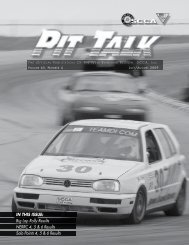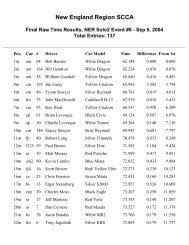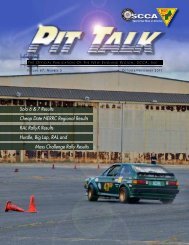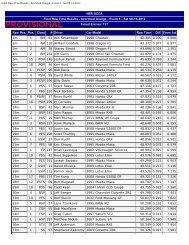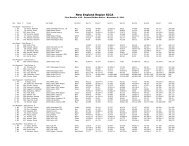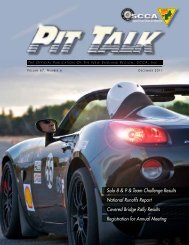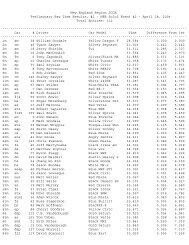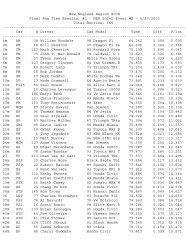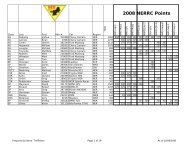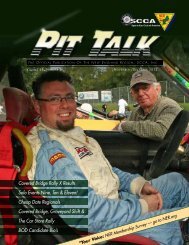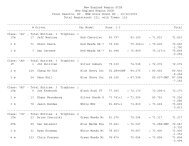NEW ENGLAND REGION OF THE SPORTS CAR CLUB OF AMERICA
NEW ENGLAND REGION OF THE SPORTS CAR CLUB OF AMERICA
NEW ENGLAND REGION OF THE SPORTS CAR CLUB OF AMERICA
Create successful ePaper yourself
Turn your PDF publications into a flip-book with our unique Google optimized e-Paper software.
Formula VeeThe Formula Vee (FV) race car is anopen-wheel racer with engine, drive train,and suspension from (or based on) the VWBeetle. Formula Vee first appeared in the1960’s and quickly became one of theSCCA’s most popular classes, both for itsaffordability and its promotion of individualcreation and design.Formula 500A Formula 500 (F500) racing car issomething of a cross between a Formula Veeand a Go Kart. These open-wheel, opencockpitcars are powered by a two-strokesnowmobile engine. They are generallyfaster in a straight line than a Formula Vee,but don’t corner quite as well.Don Denomme has been driving a classic Club Ford for years.Photo: Doug@the16V.comFormula FordThe Club Formula Ford category was createdas a home for older Formula Fords thatwere no longer competitive against newerand more up-to-date Formula Fords. SinceFormula Ford has always been considered astepping stone to higher levels of Formula Carracing throughout the world, there are plentyof Club Formula Fords out there in the racingworld. On the down side, they will cost moreto buy and require more maintenance than aFormula Vee or Formula 500.Sports RacerThese are purpose-built road racing carsfeaturing full composite bodies and,generally, open cockpits.The C Sports Racer (CSR) and D SportsRacer (DSR) feature a variety of home-builtand manufacturer-provided chassis whereinnovation is the key word. While theseSports Racing categories have certain rulesand limitations designed to create a levelplaying field and control costs, these arecategories where a creative and talentedperson or team with a dream and a designcan create their vision of the ultimate racingmachine.Sports 2000Sports 2000 (S-2) is an open-cockpit midenginedcar using a modified Ford‚ series2000cc engine with a single overhead cam.Spec RacerThe Spec Racer was originally introduced asan entry level class where all the cars wereequal. The class was an immediate successand provided racers both new and old withplenty of close racing. The cars are poweredby a “spec” Ford engine designed by RoushRacing.Because of the class’ popularity,there are plenty of Spec Racers outthere to be bought, but also becauseof the popularity, they are not exactlycheap, and the new ones have aprice that is hard to consider entrylevel.Other Regional-OnlyClassesBesides the already mentionedImproved Touring and Club FormulaFord classes, there are otherRegional-only classifications for cars.These classes include:Super ProductionOne of the newest classifications of racing inthe SCCA is Super Production (SP). SP carsare also some of the fastest and most exotic.SP has simple rules. The car as configuredneed not comply with the rules forclassification in GT or Prod. The onlyrequirement is that all cars must meet SCCAsafety regulations. Some of the cars look likeold Can Am cars, others are high- winged,twin-turbo Porsches, Baby Grands, or 7/8thPro Stocks. Super Production cars aregenerally custom-built racing machines thatwere originally built for a purpose other thanclub racing.Classic GT 1-3These are older GT cars without tubeframes.The 1983 GCR and GT class rules apply tothese older GT cars.SPEC Miata:Probably the most popular class in Regionaland National racing! This is a special classfor Miatas only (obviously). Rules are wordedsuch that all cars prepared for the class shouldbe the same. The cars incorporate all safetyaspects, but are modified very little. The carsare a ball to drive, are basically bullet proof(Many times you may se one Spec Miatarunning numerous other classes on the samerace-weekend) and obviously, very affordable.Legends:Legends cars are legal to race with SCCA.There are minor changes which need to bemade in order to make the car legal. Ask themanufacturer for the SCCA Homologationpackage.So Which One’s for Me?Given this wide range of classes and the vastnumber of cars within each class, you areprobably wondering which class is right foryou. The best way to figure this out isto come to the track, walk around the pits,and talk to the drivers. They can give youinformation about the pluses and minuses ofthe class they have chosen. When you’reready to get your competition license andthink you have an idea of which class you’dlike to be in, rent a car from that class for yourdriver’s school.If you’re looking for some guidance abouta class you are interested in, please contactone of NER/SCCA Drivers Representativeslisted on page 4.So popular are Spec Miata’s that they consist of tworace groups on an average regional racing weekend.Photo: Doug@the16V.comPhoto: Leigh McBrideThe NER Race WorkerHow to Enjoy the Best Seat In The HouseBy Mack McCormackIt takes a large number of volunteers to supportand protect the drivers who race withSCCA. These are some of the activities thatSCCA workers enjoy doing.Flag & Communications (F&C): Severalteams of marshals (Flaggers) are stationedaround the course (usually just before acorner) and the members of the teams allhave a unique and important job. Theflaggers display flags of different colors thathave special meanings to the drivers. Theflags tell the drivers to slow down or stop, goto the pits, or watch out for a slippery track,for example. The communicator uses a radioto tell Race Operations what is happening onthe course. If a car goes off course, it is thesafety/outpost responder who will attend tothe vehicle and/or the driver.Race Operations: In the tower overlookingthe race course, Race Operations is staffedby a control operator, a recorder, andan operating steward. Together, thesevolunteers gather information from the cornerstations; create a log of all communications;direct the movement of wreckers and otherresponsibilities to keep the even in operation.Starter: The starters usually stand in aspecialized flag station above the Start/Finishline. They wave the familiar green andcheckered flags, but they also may show allthe flags displayed at the other flag stations.The starters constantly keep track of thenumber of laps and the order of the cars, sothat they know when and for whom to wavethe checkered flag.Sound Control: The sound control marshalis responsible for monitoring the sound levelof each racecar. He/she also maintains andcalibrates the sound measuring equipment,and makes frequent measurements oftemperature, humidity and barometricpressure, since these can affect the cars’sound readings. SCCA has a maximumsound reading limit for every car at everyrace.Grid Marshals: Grid marshals line theracecars up in the proper starting orderbefore every race. They perform a lastminute safety check to be sure that thedriver has the proper credentials andequipment.Pit Marshals: These marshalsare assigned to the pitlane to direct localtraffic and ensurethat safety rulesare maintained in thepits. They also may assistthe Pit Steward in gatheringinformation about on trackincidents.Emergency Services:Emergency Servicesis staffed by marshalswith highly specializedtraining in fire fightingor emergency medicaltreatment. They areexperts in the safe removal of a driver froma damaged race vehicle. They may becalled to an incident anywhere on the racecourse by the F&C marshals who are the firstresponders.Timing and Scoring (T&S): The marshals intiming and scoring keep track of the positionsand lap times of each competitor on thecourse in every practice, qualifying, or racesession. Results are published at the end ofevery session.Scrutineers: The scrutineers or technicalinspectors evaluate each racecar forcompliance with all safety regulations as wellas the specific rules for the class in which itruns. A full tech inspection is done annuallyand all or part may be repeated at any event.Stewards: At every race there are stewardsperforming a number of activities. Thecommon theme among them is that thesevolunteers are responsible for administeringthe event, maintaining order, settlingdisputes, and ensuring that the eventis conducted in a safe and fairmanner.All of the jobs above areperformed by people whoseonly previous qualificationwas that they enjoyed beingaround cars and racing.Training is provided in allspecialties and entry levelenthusiasts are alwayswelcome.If you love racing, come andjoin us! Its simple and easy, justcall up the specialty head (listed onpage 4) that you may interested in, theyare sure to welcome you and extend aninvitation to come join us!20 PIT TALK PIT TALK February/March 2008 21Photo: Scott Dowd




